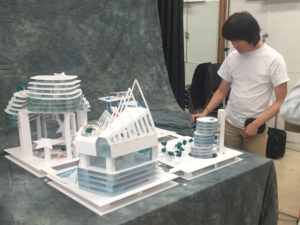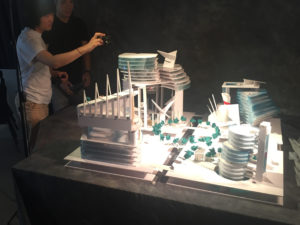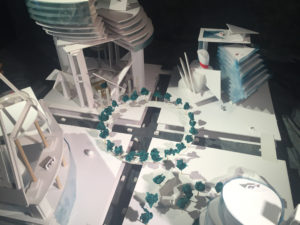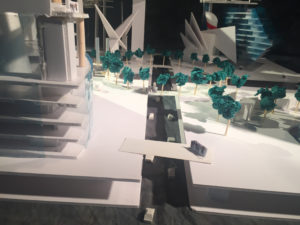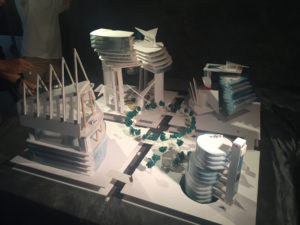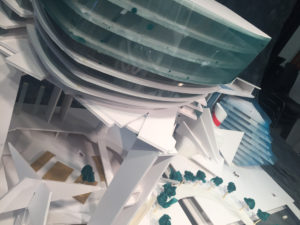Someone recently asked me for some ideas re their submission and portfolio. (Seems to happen every year around this time :). I do not consider myself an authority, but I have given it some thought and maybe this will help. I have received positive feedback from successful applicants. Also, see my other posts on this subject. There may be some redundancy, sorry. I have seen the process both as an applicant and as an adjudicator (albeit some years ago) and some things are fundamental and enduring. The following thoughts may or may not be relevant to the exact school or program you are submitting to – you be the judge. Don’t blame me if you don’t make it in the first time. (Also, don’t blame me if you DO get in 🙂
All Design disciplines have a left-brain/right brain thing happening and schools want to know that you have potential for both. Perhaps your background is more on the technical side, so that it proves you have the left brain thing well in hand. I am pretty sure any faculty would see that. Don’t hide your tech side, but don’t let it lead the parade. Go ahead and show some pictures with you on-site in a hard hat. It’s the right-brain side that you may have to develop and ‘prove’ by showing evidence in a portfolio. Now, that doesn’t mean you have to show that you are vanGogh or Rodin, but you should try to develop certain relevant skills:
VISUAL LITERACY AND DESIGN ENABLEMENT: Show that you know how to draw objects and spaces in perspective, just 1-point and 2-point (basics of or introduction to perspective). Draw many small objects and rotate them. Learn to draw small scale figures and show them in perspective in spaces (Scale figures in perspective). Show that you understand orthographic drawings (ortho-doodles). Painting is probably less important, but pursue anyway. Do some 3D work – sculpt a head, sculpt a figure in clay – photograph them but don’t cast them as it’s far too much time and work. Learn to build a design ‘sketch’ model as a sculptural exercise in hot glue gun and foamcore. Do you play any musical instruments or sing? – This shows aesthetic inclination “Architecture is frozen music”. Do you ‘perform’ in any way – acting, music, public speaking? These are life-skills that designers need. Do you have any experience with the elderly or otherwise handicapped? Do you teach anything? (Show that you are interested in people and how they life. After all, Design is for, and includes, People – be a humanitarian). The idea is to think about how you look to evaluators – Don’t be Bland – be a ‘Brand’. Everyone is. If you have a hard time seeing it – ask for the opinion of others.
CREATIVITY and CREATIVE PROBLEM-SOLVING: Have you ever originated anything or solved problems by looking outside the box?
LIFE-SKILLS & LEADERSHIP: Evaluators often have in the back of their minds the thoughts – Will this person contribute something to the cohort studio class, perhaps something unique? Does this person have leadership potential, as a Designer out in the world, as a colleague, or perhaps as a teacher, down the road? Has this person run a business or organized an event, themselves? All this goes to ‘life-skills’ that come from working with others, organization, and perseverance. If you can, show that you have these qualities. If you can show photos in this regard, do it. For example, how about a ‘ME’ page that provides some photos that are visual evidence of you exhibiting these behaviors, or some of them?
PERSONAL BRANDING: Ask yourself, or others, “What makes me stand out against the others, what makes me unusual or even unique?” Ask others to tell you this if you can’t make it out for yourself. Here’s why you need to determine that – Every faculty receives many times more applicants than it can take in. Think how they process, perhaps 100 or more portfolios, for 25 first year spaces. Imagine several faculty members and, perhaps, a couple of senior year students going through the application folios. Here is one way it could be done – first might they go through them very quickly for the immediately obvious “Yes” group and separate them (so the secretaries can begin writing acceptance offers). Imagine they then go through the remaining group again for the “Sorry but No” group and separate them . (Secretaries can begin writing the ‘regret to inform you’ letters). Assume all this takes up 5 of the available 25 spaces, so there are 20 left open. If you fall in one of these groups, and you probably would have a good idea about that at the outset, you can relax. Let’s say they are now down to 50 applicants for the remaining 20 spaces. This final group is the “Maybe” category. These are the ones the committee has to spend the most time carefully evaluating. Here is the thing – What makes you stand out as an identifiable ‘brand’ in this group? I have known of a female Thai-boxer, a person who kayaked the Northwest Territory, a Tibet-mountain hiker, a ballet dancer with a national ballet company, a person who based his entire portfolio on jewelry he made from fishbones. Now, assuming they are otherwise qualified, imagine they are in the “Maybe” group. Don’t you think the evaluators would say “Let’s look at the ‘fish’guy again, that Thai boxer again, etc.”? They would be much less likely to say “Let’s look at that person who was pretty much the same as everyone else, again”. This is another good reason to go to an Open House. Be memorable. Be keen. Wear a nametag, and after the spoken presentations say ‘Hello, I’m Rachelle and thanks very much for the insights. Your talk really gave me a sense of what your program is all about.’ to as many of the presenters as you can – assume they may be evaluators and will have good memories. They often remember and they think they may be meeting future colleagues, not just students.
DATE OF SUBMISSION: In case of ties the ‘Date of Receipt of Submission” can be used to select from perhaps the last 3 or 4 people, all other things being equal. So- ideally submit a few weeks before the deadline. Also don’t ask for recommendation letters at the last minute – you don’t get the most supportive letters over Christmas Holidays. Find out if the entire submission has to be received before you are given a”date of submission”. Maybe some components can come later. Depends on the school. Here is another thought – when the school or program sends out acceptance offers there is always a number of people who decline. They may not have the money or it may be a hectic time in their lives, or they may have offers from other schools with more attractive attributes or locale. The very top candidates may have offers from 3 or 4 schools. So what happens then? Often schools have a point system and just go down the list to make more offers after the deadline for acceptance has passed. Or, schools can also use the Date of Submission in case of ties. They have to fill the number of available eats somehow. So they may have several ‘back-up’ candidates selected who are declined initially, but who may get a positive offer in the mail later on until the places are filled.
KNOWLEDGE OF THE PROFESSION: Prove to the evaluators that you have your eyes open and didn’t just wake up one morning and think “Wow, I want to be a designer!” Contact the local professional licensing entity. Get names of several registered designers who might be willing to communicate with you about the profession. You can meet personally (best) and/or you can email a questionnaire. Develop an actual questionnaire of about 5 questions, for example – How long have they been in the profession? What made them go into the profession? Did they have a previous profession or work life? What do they like most about their work? What do they like least? Would they do it again? Or any other questions you might find interesting. Have the questions pre-planned so you don’t waste peoples’ time. Put the results in summary form in your submission.
CHANGE IN CAREER PATH: Do not say “I hate my job and I think I will go and be an architect”. Do say “Becoming a designer is the obvious next development step in my career path.” Everything you have done in life is related to architecture or other design fields. Just google : architecture and shoes, architecture and music, architecture and construction is obvious, etc. Hint: if you google ‘shoes and architecture’, you can get different results from googling ‘architecture and shoes’. Nothing is so irrelevant that someone hasn’t done a masters thesis or even a phd on the subject. Thai Boxing? – They have to strategically assess, predict and strategize their position in the ring constantly being aware of the choreographed movement of people in space – sound like architecture?
HEREDITY: I am sure most schools would deny this, but many people think if your grandmother and great-great grandfather were in construction maybe there could be an innate tendency in you. (True in my case). Don’t play it up too much, but saying “I was inspired as a child hearing stories about my grandfather doing heritage reparations on buildings in the old country”, I would think is fair. But – Don’t name drop famous designers you are related to. It can make it seem you think you are entitled.
GET AN OUTSIDE OPINION: Ask one or two people (not me please 🙂 to look at your portFolio before you submit.
JUST DO IT: Many schools post successful portfolios on their websites. Don’t be intimidated by these. Assume these are the strongest candidates. Of course, they don’t put up the weakest. Don’t over polish, procrastinate and delay submitting. You might stack up better than you think against the competition that particular year. If you are successful, you save yourself an entire year! Better odds than the Lottery! I have more than one letter from people thanking me for telling them to just go for it. Just do it!!!
JUST DO IT AGAIN: Also, many people who get into programs have previously been rejected. Get feedback (be persistent about this) , rework and resubmit. For this reason, send your reference letter-writers a coffee-card and profuse thanks because you may need them again. Don’t be discouraged by a rejection. It’s not personal. It’s one step closer to a ‘yes’.
Good luck! T
